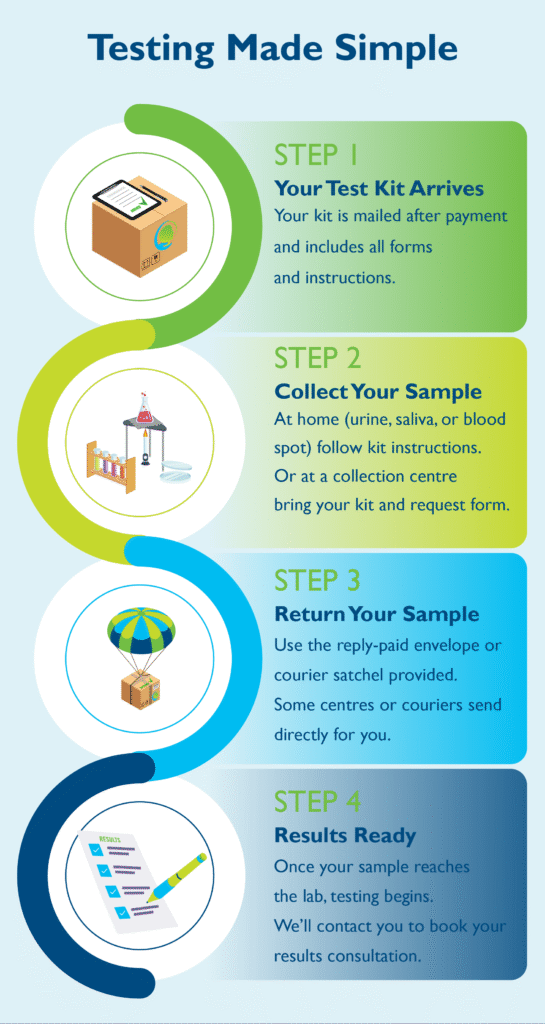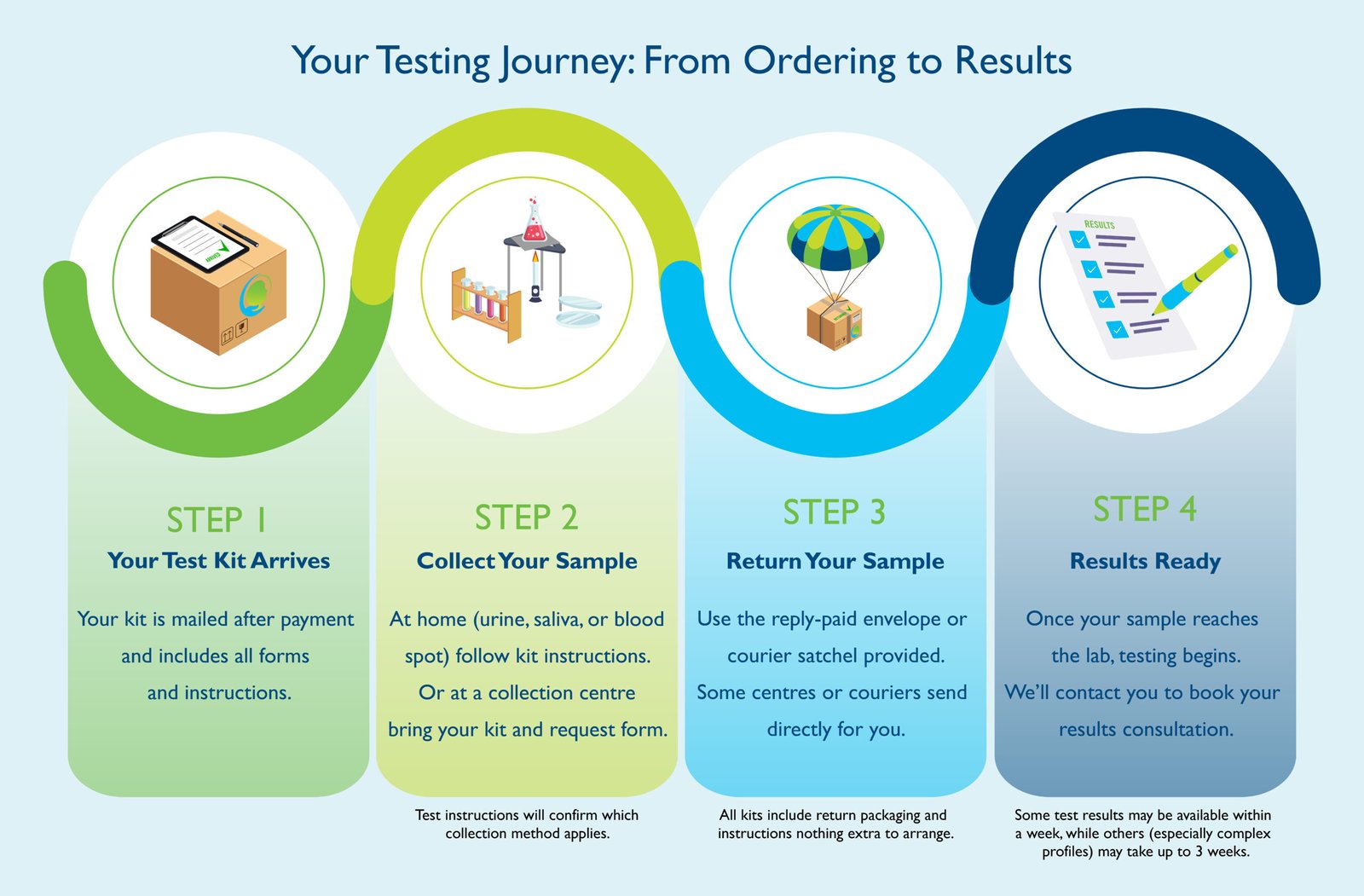Gluten Sensitivity Testing: Coeliac, Wheat Allergy & Non-Coeliac Gluten Response
Gluten sensitivity testing assesses the body’s immune response to gluten and its protein fragments. This includes markers for Coeliac disease, non-Coeliac gluten sensitivity (NCGS), and wheat allergy. Many individuals experience bloating, fatigue, skin issues, mood changes, or IBS-like symptoms after gluten exposure—even if they don’t meet the criteria for Coeliac disease.
With minimally invasive dried blood spot or serum testing, this panel identifies which category you may fall into – so you can take action with clarity and confidence.
Not sure where this fits? See our Pathology Testing Packages & Pathways to choose your starting point → /pathology-testing-packages.

There are three primary types of immune reactions to gluten:
- Coeliac Disease (CD):An autoimmune reaction where gluten damages the small intestinal lining
- Non-Coeliac Gluten Sensitivity (NCGS):Inflammatory symptoms without autoimmune antibodies or intestinal damage
- Wheat Allergy (IgE):A classic allergy with immediate reactions like hives, asthma, or anaphylaxis
This test assesses multiple immune pathways:
- IgA and IgG antibodiesto tissue transglutaminase (tTG) and deamidated gliadin peptide (DGP) — key markers in Coeliac disease
- IgG/IgA anti-gliadin antibodies— associated with gluten sensitivity, autism, schizophrenia, and more
- IgE wheat antibodies— screen for immediate wheat allergy
- Total IgA— helpful to rule out immune deficiency that can mask results
“Even when standard Coeliac tests are negative, this deeper screening can detect hidden immune responses to gluten.”
Gluten sensitivity isn’t just a digestive issue—it’s an immune and neurological trigger. Research shows that even without classic Coeliac disease, gluten exposure can drive brain inflammation, disrupt neurotransmitter balance, and trigger mood, cognitive, and psychiatric symptoms.
This test assesses hidden immune reactions to gluten that may underlie:
- Depression and Anxiety
Chronic low-grade inflammation from gluten can impair serotonin production and worsen depressive symptoms. - Schizophrenia and Psychosis
Anti-gliadin antibodies have been found in a significant number of patients with schizophrenia. Dr. Greenblatt emphasizes that gluten-related antibodies may act as a “silent neurotoxic driver”for some individuals, contributing to psychosis and cognitive dysfunction. - Cognitive Fog, Fatigue, and Mood Swings
Even in the absence of gastrointestinal symptoms, gluten sensitivity can affect gut-brain communication, leading to mental sluggishness, irritability, and energy crashes.
While gluten-free diets are often trialed based on symptoms, testing provides clarity on which immune pathways are involved (autoimmune, allergic, or inflammatory), guiding a more targeted and sustainable intervention.
Dr. Greenblatt teaches that identifying gluten-related immune responses allows for tailored treatment, whether it’s a strict elimination, rotational approach, or focus on gut repair strategies alongside dietary changes.


Your Testing Journey: From Ordering to Results

STEP 1

STEP 2

STEP 3

STEP 4
Coeliac Disease Panel
- Tissue Transglutaminase (tTG) IgA
- Tissue Transglutaminase (tTG) IgG
- Deamidated Gliadin Peptide (DGP) IgA
- Deamidated Gliadin Peptide (DGP) IgG
Gluten Sensitivity Panel
- Gliadin IgA (α, β, γ, ω sub-fractions)
- Gliadin IgG (α, β, γ, ω sub-fractions)
- Gluten IgG
Wheat Allergy Panel
- Wheat IgE
Additional
- Total IgA
🧪 Combined, these markers help detect gluten reactivity even in children and IgA-deficient individuals.
- Option 1: Serum collection kit (for pathology centre use)
- Option 2: Finger-prick home kit
- Sterile lancets, alcohol wipes, blood spot card
- Instructions + return envelope
- Stable at room temp, 21-day viability
1️⃣ Prepare the Kit & Area
- 📋Ensure you have all the kit components:
- Blood Spot Collection Card (attached to kit insert)
- 🩸2 x Single-use Lancets
- 🧽Alcohol Wipe
- 🩹Band-Aid
- Sterile Gauze Pad
- Requisition Form
- Biohazard Zip-lock Bag
- ✉️Prepaid Return Mailing Envelope
2️⃣ Pre-Collection Instructions
- 🧼Wash your hands with warm soapy water and dry thoroughly.
- 🚫Do NOT eat, drink (except water), or brush your teeth for 30 minutes before collecting.
- 🥤Ensure you are well-hydrated for easier blood flow.
- ❗If on blood-thinning medications or have a clotting disorder, consult your practitioner.
3️⃣ Collecting the Blood Sample
- 🩸Use a lancet to prick the side of a fingertip (do not use the little finger).
- Wipe away the first drop of blood with sterile gauze.
- Apply 6–9 large drops of bloodonto the blood spot card, filling the marked circle.
- Ensure the blood soaks through to the back of the card.
4️⃣ Drying the Sample
- ❄️Air dry the card for a minimum of 3 hours in a safe, clean area away from sunlight and moisture.
- 🚫Do not layer drops, smear blood, or touch the card’s collection surface.
5️⃣ Packing the Sample
- 📄Complete the requisition form with your details.
- 👜Place the dried blood spot card into the biohazard zip-lock bag.
- Ensure as little air remains in the bag as possible.
- Include the requisition form inside the return mailing envelope.
6️⃣ Registering Your Kit
- 📲Complete the online registration using the barcode on your collection card.
- Fill out any questionnaires as required.
7️⃣ ✉️ Shipping the Sample
- Post the sample on a Monday or Tuesday onlyto avoid weekend delays.
- 📮Drop off at a post office or post box before 2pm on the day of collection.
💡 Important Collection Facts:
- 🧬First time testing? You only need to test once for genetic predispositions.
- 🚫Avoid sample rejection by ensuring:
- Blood fully saturates through card.
- Requisition form is complete and signed.
- Do not layer drops or smear.
- ❗RN Labs is closed mid-December to early January — avoid posting during this period.
⚠️ Common Mistakes to Avoid:
- ❌Touching the collection card with your fingers.
- ❌Adding drops on top of already dried blood spots.
- ❌Forgetting to register your kit online.
- ❌Mailing the sample late in the week.
- ❌Not including the requisition form in the return envelope.
💡“You don’t need a gut biopsy to know gluten is a problem. This test reveals what your immune system thinks of it”
Book your Appointment
15-MINUTE FREE DISCOVERY CALL Confused about testing? Talk to me first.
I’m the practitioner behind BalanSoul. In 15 minutes we’ll map your best next step what to test (and what not to), likely costs/timing, and how it links to your mental health goals.







